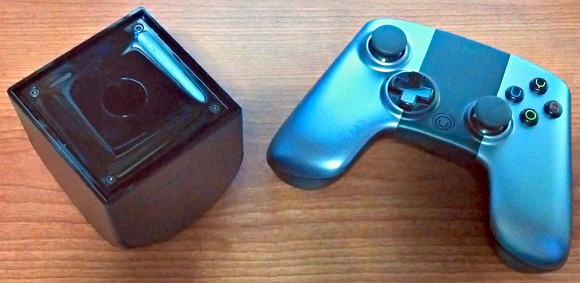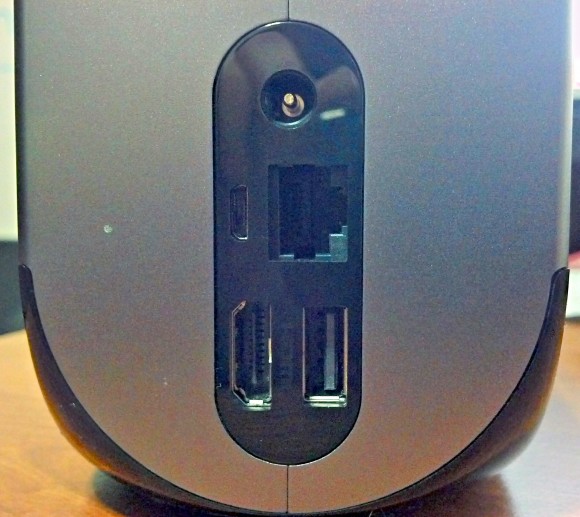Updated Jan. 23, 2017
aNewDomain — Ouya promised a splash back in the day, but it’s more of a soft plop right now.
If you spent any time at all focusing on gaming or Android back in 2013, you remember Ouya. The Android gaming microconsole was the fifth most successful Kickstarter project at that point.
It raked in $8.5 million from more than 63,000 backers, easily exceeding an original goal of $950K. Not bad for a little startup with a new kind of product for an emerging segment — and on a new crowdfunding platform.

When I reviewed the Ouye in these pages, I was just beginning my journey as a journalist reviewer.
So when my editor told me reviewers aren’t allowed to cover products they buy or have invested in, I was surprised. Seemed arbitrary, I thought. But she said it’s hard to look at a product with the fairness and objectivity a reader needs from a review if you’ve already invested your own cash in it. I wasn’t sure, but fine. And anyway, I was getting one anyway, right.
In the end, we decided the opportunity to check out this product was just too good. After all, it was a $99 Android Jelly Bean-based console that was built with rooting, extending and easy modding in mind. It was for developers and tech pros like me, clearly, right down to the fact that every Ouye system was supposed to be usable as a full development kid, with no licensing fees. And did I mention Ouye ensured that all the games would be free to play?
So I couldn’t do a regular review, like I said, because I’d participated in the Kickstarter campaign. My editor reframed the assignment as a first person account of what it’s receive a tech product you backed on that platform. Would it be everything they promised?
I was about to find out. But it wasn’t until now, five years later, that the real lessons of the ill-fated Ouye hit home.
Let me explain ..
Rewind to March 2013
You may remember that its Chinese maker pitched the Ouye on Kickstarter as an Android-based video gaming console for TVs. Wireless controllers, Wi-Fi and other features, coupled with free game play, weren’t totally new in 2013, of course. But the pricing, design and consumer approach were.
I received mine in March 2013, two months before the company began shipping to buyers outside of Kickstarter.
I was ready to love it, I was. But the minute I took it out of the box, the love affair turned into something far more bittersweet.
The first nit was small. Where were the instructions? There was no Quickstart guide, no manual, no little card, no smoke signals, no nothing.
 Back then, a choice like that might have seemed like a mistake – or maybe, to some, like the kind of bravado only a small company that knew its product “just worked” would have.
Back then, a choice like that might have seemed like a mistake – or maybe, to some, like the kind of bravado only a small company that knew its product “just worked” would have.
I didn’t like it. No advice on even the basic hook-up details seemed slack to me.
Then I started looking at the hardware. I checked out the wireless controller for the device first.
Then, as now, good design sets a newcomer apart. The Ouya had it. It fit nicely in my hand. The button lay out, in a design that’s now fairly standard, looked fresh and well thought out to me back then.
Installation did turn out to be easy, and I had started to play one of the games it shipped with when the trigger buttons started sticking. Yes, during gameplay.
Now, I wasn’t going to mention a small, annoying thing I’d noticed before I started playing., Ouya had left the plastic film from manufacturing on the controller. Now, with the sticky buttons, that manufacturing oversight screamed low-budget. Cheap.
All the currency it had earned in my mind from being such a successful Kickstarter launch was lost at this point.
Ouye didn’t spend all that crowdfunding dough on small things. Why?
That question should’ve gone right to the company, of course. All fair reviews let the product maker answer and explain the negatives. But because this wasn’t a true review, but a story about a Kickstarter investor’s out of the box experience, I didn’t do that. I was supposed to be a real buyer, and real buyer’s don’t have a PR or company contact at the ready.
I had to waste more than 45 minutes removing the casing, by the way.

And another thing it made me reevaluate was this: When I connected the device at the beginning, there was a substantial system update. That wasn’t a negative at the time. I tend to think that such a first-time update usually gives me faith. It shows developers are putting the software front and center, and they care about still updating the product. I wasn’t going to mention it as a negative.
But after the update, the system forced me to reconnect after the update — for bluetooth pairing!
My disappointment grew.
The shape of things to come?
A lot of reviewers would have abandoned the whole project at this point, slammed the new product for cheapness or even made fun of the KickStarter people who parted with their money for it.
Given that I was one of them, though, I persevered.
I was glad I did then, and now I’m even more so. Because, despite all these signs of slack attention to detail, the system was super easy to navigate. It was so easy, I wouldn’t hesitate to let even small kids play with it.
Then, more good news: Downloads and game installations were easy and quite speedy.
That’s a lesson I wouldn’t have learned had I been conducting a normal, journalistic review on a system I hadn’t invested my own cash in. I stuck with it, as most of my fellow KickStarter investors would. Out of hope, more than optimism, maybe.
The bottom line
These days, you know, reviewers are always looking for a way to set their reviews apart from other reviewers by making them smarter — or snarkier. But things aren’t so black and white, and even a cheaply made product that overlooked such key details as the plastic film on the buttons — or a stuck button — can have good points. Not mentioning them, really, is actually a huge disservice to readers — who aren’t there so much to be entertained by headline grabbing pans or over the top fawning, but just to find out what’s good and bad about a product.
Shouldn’t prospective buyers be trusted to take in all the facts — the good with the bad — in total — and let them decide for themselves what flaws they’re willing to pay for in return for whatever new or innovative functionality a new product offers?

It’s true that things didn’t end well, from my perspective. I tried three games that it shipped with, I thought they were all uninteresting — after a few minutes, I was bored. Would everyone be just as bored? No telling. Games are so subjective. Now I’m not a huge gamer, but like everyone, there are some game types I like and others I could care less about.
Time will tell if developers write new games or port existing ones to the Ouya, I wrote at the time.
Were I to do it all over again, I would’ve described the games in detail and, when I said I was bored by them, I would have explained what I found boring about them. The thing, again, is to give readers the facts and let them decide for themselves what they can and can’t agree with. Sticky buttons and cheap materials are qualities most people would agree are not good things. But one man’s boring game is another man’s Tetris. Or whatever.
You get the idea.
I recall also that the device came with a complete and utter lack of apps that came via browser and Netflix, too. But looking back, that was a hard thing to knock. Developers flock to a system based on the excitement it creates among buyers and techies, and also on the promise its SDK holds.
These are the sorts of considerations that Ouye review taught me way back then, considerations that reviewers should especially think about now that everyone and his brother can create a professional looking online review site and use social to get it widely read. We have a bigger responsibility now because there is so much noise …
At the end of my review, I closed with this comment: “I’m disappointed, but I’m not giving up yet. Ouya strikes me as the type of project that will continue to improve. If they do, I’ll be waiting to check in on the advancements and give them the chance to impress me. For now, though, this funny-looking box is likely to collect dust in my closet.”
Was that comment something that would lead someone to make a decision based on what they are willing to sacrifice for cost — or innovation — or ease of use?
And was I right about Ouye? Well, no. It failed — hard.
But I was right about it collecting a ton of dust in my closet.
And the review, too, ended up being stowed away — in my mind. By 2016, the product was gone. I reread my review and noticed something — the lesson it delivers about how to review a product fairly and without headline-grabbing antics, about delivering the facts and taking extreme care to report those facts and check them — well, that’s a lesson for all journalists now. Not just reviewers, everyone.
Because in 2017, when fake news, native advertising and terms like “alternative truth” are wielded about (that one by Trump spokeswoman Kellyanne Conway just today) flying about — and as purveyors of those things defend themselves by using every mistake real journalists to ruin trust in the media — well, I think you get it.
We’ve never needed to back up our assertions, check facts and go the extra yard for fairness more. Journalists have always aimed to deliver the most objective news and insights as is possible, but it’s no longer enough. The Ouye didn’t die for nothing, I guess. But that’s just my opinion.
For aNewDomain commentary, I’m Jeremy Lesniak.














I’m a freelance tech writer who’s always hassling to find work. Part of my problem is the stream of bright young technically-savvy tech writers that schools are grinding out these days. Another is that developers are more literate and can often do passable docs without my help. Finally, there are these lean startup models which say that you minimize costs until you have some reliable income. These are all problems that I file under “grow or die”.
But the fact remains that a lot of projects just don’t give a carnal act about docs. That’s pretty obvious in this case. Ouya told us they could develop this device with slightly less than $1 million. They overshot that goal by over $7.5 million. So with all that cash, they couldn’t hire a tech writer? Or at least tell one of their more literate developers to write up the installation instructions? Obviously Ouya has the “Users will figure it out” attitude.
It’s self-serving of me to say this, but it’s also true: that’s dumb.
Why would a pre release developer edition come with instructions? Lol